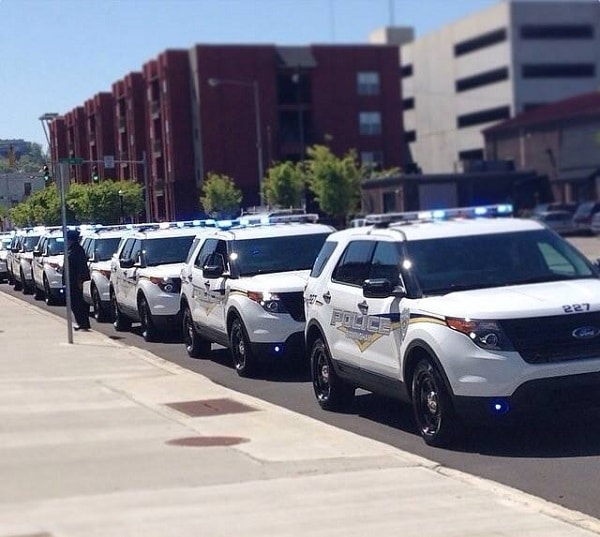The Birmingham Police Department faces a critical staff shortage. The department has 250 fewer officers than what its budget calls for.
But that’s actually an improvement. As recently as June, police spokesman Truman Fitzgerald said the department was down 320 officers. By some estimates, that’s about half of a fully staffed BPD.
Fitzgerald says the understaffing has forced the department to adapt.
“It certainly changes the shifts that we’re working right now,” he said. “Our patrol officers are working 12-hour shifts. We have to pull from different resources, within our other units, to make operations flow smoothly.”
The staffing shortage has created the need for other operational changes.
“It’s easy to see what we were able to do when we had more officers, versus now,” he said. “And what I can attest to when we had more numbers … you were able to give individualized attention to certain areas and certain problems that are going on in the community.
“You saw more specialized patrols that were able to be sent out into the neighborhoods, versus now, when our officers are often going from call to call to call to call to call.”
Crime stats
When asked if the lack of officers is having an impact on fighting crime, Fitzgerald said he hasn’t seen actual data. But recent crime statistics show a mixed bag of trends in the city.
Earlier this year, the numbers showed some crimes stats, such as rape, robbery and theft, were down by double digits. A cyberattack in March hampered BPD’s ability to track several crime stats.
But homicides are up by as much as 14%. That includes a number of high-profile killings in recent months, including when seven people were shot and killed in two separate incidents on July 13. One of the those murdered that weekend was a five-year-old boy, killed with his mother and her friend in a targeted shooting.
Woodfin on police recruitment
Birmingham Mayor Randall Woodfin addressed the staffing shortage at a press conference on Wednesday. He pointed at two major causes: the coronavirus pandemic, which many experts say exacerbated a sense of burnout among many public-facing employees, including healthcare workers and teachers, as well as police officers. Then, in the midst of the pandemic and unique to law enforcement, came the murder of George Floyd by members of the Minneapolis Police Department.
He said the incident, and the video of it, was not isolated or contained within the city limits of Minneapolis.
“When George Floyd was killed, that sent an unfortunate ripple out to the next generation of people, who wanted to be police officers,” Woodfin said.
It caused, Woodfin said, fewer people to apply to work in law enforcement. It was the beginning of a four-year trend that is only now beginning to turn.
A nationwide staffing crisis
Chuck Wexler is the executive director of the Police Executive Research Forum. A national think tank for law enforcement agencies, PERF has surveyed its membership on staffing. That membership includes police, as well as sheriff’s departments and other agencies, such as state law enforcement and university security.
“This staffing crisis is pervasive,” he said. “We saw the first signs of [it] in 2019.”
Wexler said PERF’s data showed the trend at its worst in 2020, following George Floyd’s murder.
“I just think that the narrative around policing in that period was very negative,” he said.
He added such high-profile incidents continue to happen, noting the shooting of an Illinois woman earlier this month by a police officer.
“This very tragic case sent shockwaves all across the country, in terms of hiring. When you have a video like that, it’s so disturbing that it takes its toll,” Wexler said.
BPD’s Fitzgerald largely agrees.
“Just the attention that law enforcement has gotten, some of this is well deserved,” he said. “We’ve done this to ourselves, as officers. We’ve seen throughout the nation this has given this field a black eye.”
Prior to this latest police shooting, a PERF staffing survey released in April showed hirings of new officers had rebounded somewhat, but just within the small- and medium-sized departments. Large departments— those with more than 250 officers, like Birmingham — were still facing critical understaffing.
Wexler said the survey shows larger departments, nationally, have seen more resignations and retirements, and fewer people wanting to be police officers.
“I think it has a lot to do with the sense that, in larger agencies, there’s more visibility when something happens and doesn’t go right,” he said. “The media market tends to be larger. There tends to be more public pressure.”
A potential rebound
So how can law enforcement recruit and retain officers, especially the larger agencies? Fitzgerald noted BPD is offering $5,000 dollar signing bonuses for new officers, as well as increases in pay based on education levels, among other incentives.
Wexler said some departments are offering signing bonuses of up to $70,000 and starting salaries north of $100,000. Others are even offering benefits, like take-home cars and day care.
But, he said, money and benefits, by themselves, will not solve the problem.
“I think what’s going to solve it is the sense of community support and trust that police departments build,” Wexler said.
At the press conference earlier this week, Woodfin said BPD is trying to rebuild trust and is seeing signs of a turnaround.
“We see that the current class is the biggest class we’ve had, literally since April of 2020. We’re encouraged by the next incoming class we have in November,” Woodfin said.
He said part of the reason for the upswing in recruits are outreach efforts within the local community, even nationally, to attract potential new officers.
“We want to let the next generation know we need you to be police officers, to serve your community. The trust, the mistrust you have, the best way to change it is for you to be active.”

